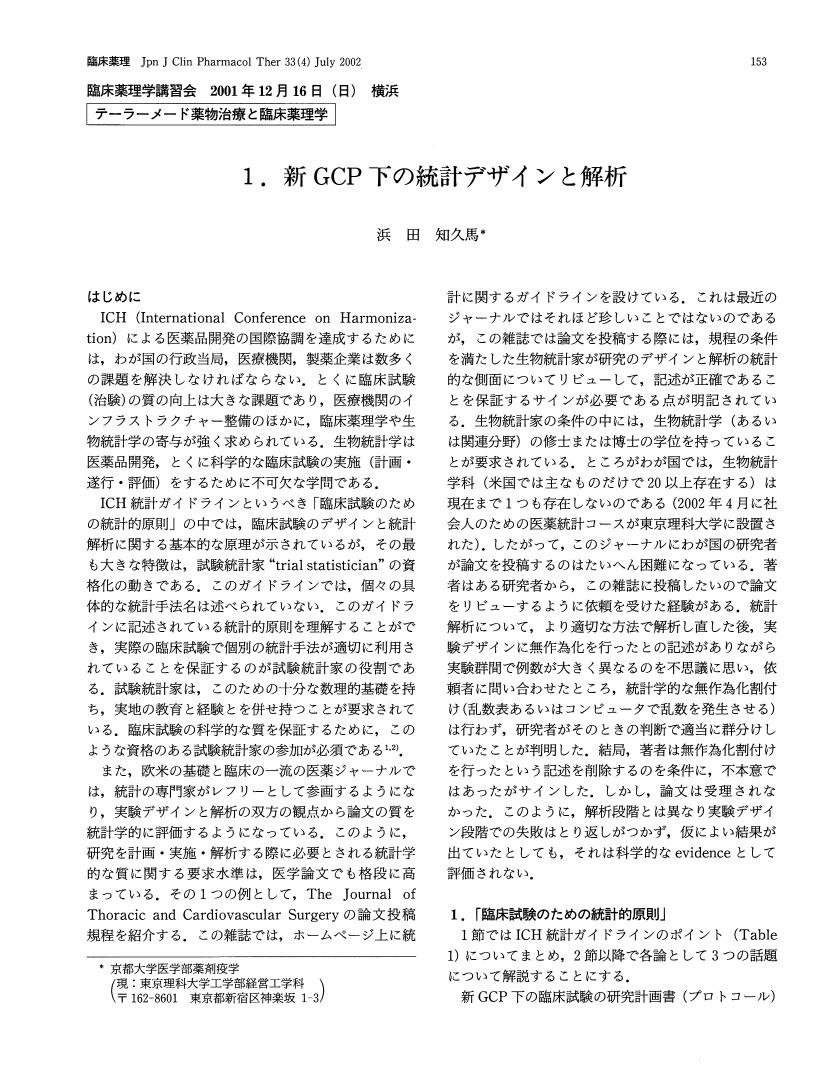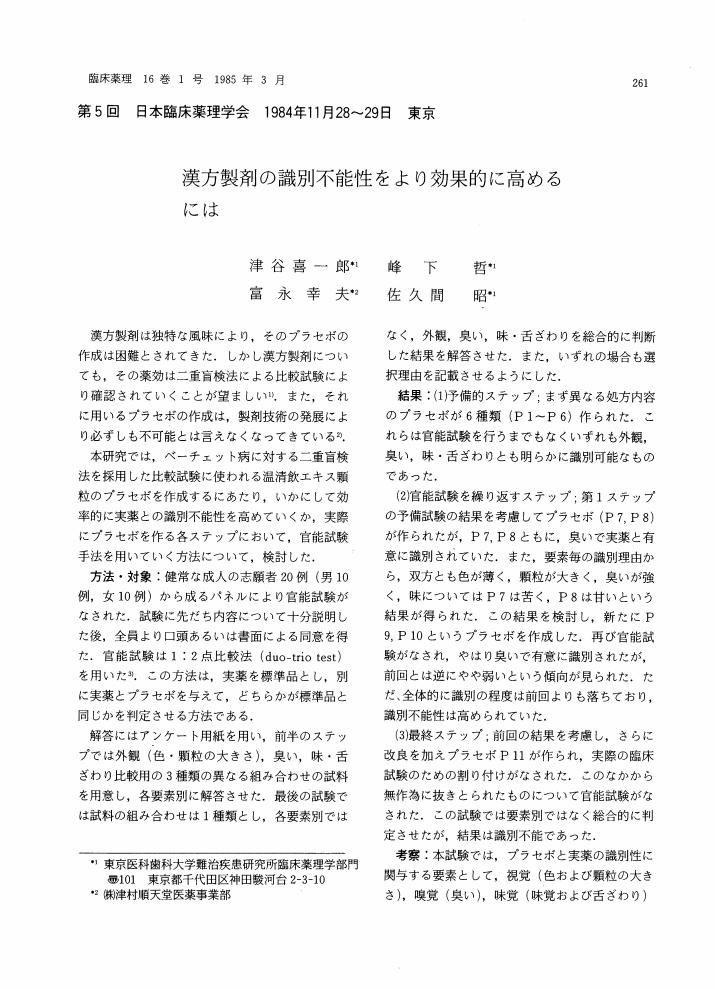1 0 0 0 OA 薬害スモンの教訓
- 著者
- 片平 洌彦 佐久間 昭 杉沢 秀博
- 出版者
- 一般社団法人 日本臨床薬理学会
- 雑誌
- 臨床薬理 (ISSN:03881601)
- 巻号頁・発行日
- vol.18, no.1, pp.135-136, 1987-03-30 (Released:2010-06-28)
- 参考文献数
- 16
1 0 0 0 OA 肺疾患 (気管支喘息) に対する免疫抑制剤の正しい使い方とその評価
- 著者
- 小林 節雄 根本 俊和
- 出版者
- 一般社団法人 日本臨床薬理学会
- 雑誌
- 臨床薬理 (ISSN:03881601)
- 巻号頁・発行日
- vol.6, no.1, pp.71-77, 1975-03-30 (Released:2010-06-28)
- 参考文献数
- 33
1 0 0 0 2. 薬物代謝の面から
- 著者
- 千葉 寛
- 出版者
- 一般社団法人 日本臨床薬理学会
- 雑誌
- 臨床薬理 (ISSN:03881601)
- 巻号頁・発行日
- vol.28, no.1, pp.79-80, 1997-03-31
- 著者
- 須永 健一郎 熊谷 雄治 原田 和博 大森 正規 海老原 昭夫 藤村 昭夫
- 出版者
- 一般社団法人 日本臨床薬理学会
- 雑誌
- 臨床薬理 (ISSN:03881601)
- 巻号頁・発行日
- vol.27, no.1, pp.37-38, 1996-03-31 (Released:2010-06-28)
- 参考文献数
- 1
1 0 0 0 1 .多併存疾患と臨床薬理 イントロダクション
- 著者
- 植田 真一郎
- 出版者
- 一般社団法人 日本臨床薬理学会
- 雑誌
- 臨床薬理 (ISSN:03881601)
- 巻号頁・発行日
- vol.52, no.3, pp.68-69, 2021
1 0 0 0 6 .薬物相互作用と現実的な対応
- 著者
- 三輪 宜一
- 出版者
- 一般社団法人 日本臨床薬理学会
- 雑誌
- 臨床薬理 (ISSN:03881601)
- 巻号頁・発行日
- vol.52, no.3, pp.89-93, 2021
<p>In recent years, many excellent drugs with few side effects have been introduced into treatment and contribute to improving prognosis, but elderly people often have multiple diseases and take many drugs in combination. As a result, the existence of drug interactions has become more important as a risk factor for the occurrence of adverse drug reactions(ADRs). In Japan as well, the importance of drug interactions has been recognized since the Sorivudine incident in 1993, in which sorivudine, a therapeutic drug for herpes zoster, caused death due to serious myelosuppressive side effects when used in combination with 5-FU anticancer drugs, and cautions have been issued such as the revision of the description procedure in the package insert. In addition, efforts are being made by various parties concerned in the drug development process. In 2018, the Ministry of Health, Labor and Welfare issued the “Guideline on drug interaction for drug development and appropriate provision of information” regarding the method of examining drug interactions and the provision of information.</p><p>On the other hand, looking at the medical field, although some side effects of individual drugs and interactions between the two drugs are described in the package insert, it is impossible to grasp all of them. In addition, even if the drug therapy is recommended in the treatment guidelines for a certain disease, if the drug is complicated with another disease, the drug interaction with the recommended drug for those diseases may become a problem. A meta-analysis of prospective studies on the incidence of drug-induced ADRs in inpatients published by the United States in 1998 estimated that 106,000 people die annually from ADRs. Healthcare professionals are required to work harder than ever to prevent ADRs. Even now, medications are checked by pharmacists, but it is hard to say that they are fully prepared for drug interactions.</p><p>In this session, I would like to describe what can be done and what kind of knowledge should be learned to prevent serious drug interactions. Based on that, I would like to think about what points should be emphasized and dealt with in the actual medical field.</p>
1 0 0 0 OA 脳循環代謝改善剤における「改善率」の経年的変化の検討
- 著者
- 金 美恵子 橋本 健太郎 林 敬次 柳 元和 三田 康子
- 出版者
- 一般社団法人 日本臨床薬理学会
- 雑誌
- 臨床薬理 (ISSN:03881601)
- 巻号頁・発行日
- vol.30, no.1, pp.197-198, 1999-01-31 (Released:2010-06-28)
1 0 0 0 ピル (経口避妊薬) について
- 著者
- 植田 国昭 加藤 順三
- 出版者
- 一般社団法人 日本臨床薬理学会
- 雑誌
- 臨床薬理 (ISSN:03881601)
- 巻号頁・発行日
- vol.8, no.3, pp.389-395, 1977
- 著者
- 永井 尚美
- 出版者
- 一般社団法人 日本臨床薬理学会
- 雑誌
- 臨床薬理 (ISSN:03881601)
- 巻号頁・発行日
- vol.41, no.5, pp.217-222, 2010 (Released:2010-11-25)
- 参考文献数
- 19
- 被引用文献数
- 2 1
Pharmacokinetics-Pharmacodynamics (PK-PD) is useful to understand the quantitative relationship between drug exposure and pharmacological outcome. In recent years, results of the pharmacokinetic analysis of Japanese patients have been frequently included in the new drug application dossier. Also, not only pharmacokinetics, there are an increasing number of cases where clarifying the relationships between pharmacokinetics and efficacy/safety data. Furthermore, PK-PD analysis has been applied to a growing range of drug development program, for example designing subsequent clinical studies using the modeling and simulation technique. The value and applied cases of PK-PD modeling and simulation in drug development have been discussing past several years, and the regulatory bodies and ICH (International Conference on Harmonization of Technical Requirements for Registration of Pharmaceuticals for Human Use) have published related documents and guidelines. The integration of information obtained during pre-clinical and early-phase clinical development and application of PK-PD modeling and simulation to a clinical drug development program is thought to be one of the powerful and scientific approaches for planning high-quality, speedy and cost-effective drug development program. However, it is a newly emerging approach especially in clinical drug development, therefore building multi-disciplinary teams, educating/training the professionals, collecting experiences to make database and intensive communication among different professionals are essential. This article reviews the current situation of this approach in Japan and regulatory point of view of the role of PK-PD modeling and simulation in drug development and approval.
1 0 0 0 OA 臨床薬理学に関する用語
- 著者
- 鈴木 哲哉
- 出版者
- 一般社団法人 日本臨床薬理学会
- 雑誌
- 臨床薬理 (ISSN:03881601)
- 巻号頁・発行日
- vol.6, no.4, pp.307-313, 1975-12-30 (Released:2010-06-28)
- 参考文献数
- 4
1 0 0 0 OA 1.新GCP下の統計デザインと解析
- 著者
- 浜田 知久馬
- 出版者
- 一般社団法人 日本臨床薬理学会
- 雑誌
- 臨床薬理 (ISSN:03881601)
- 巻号頁・発行日
- vol.33, no.4, pp.153-157, 2002-07-31 (Released:2010-06-28)
- 参考文献数
- 4
- 被引用文献数
- 1
1 0 0 0 OA 漢方製剤の識別不能性をより効果的に高めるには
- 著者
- 津谷 喜一郎 峰下 哲 富永 幸夫 佐久間 昭
- 出版者
- 一般社団法人 日本臨床薬理学会
- 雑誌
- 臨床薬理 (ISSN:03881601)
- 巻号頁・発行日
- vol.16, no.1, pp.261-262, 1985-03-30 (Released:2010-06-28)
- 参考文献数
- 3
1 0 0 0 OA 【新中医学研究】現代中国の肝保護療法における垂盆草の研究
- 著者
- 野村 正和 後藤 弘 張 岫美
- 出版者
- 一般社団法人 日本臨床薬理学会
- 雑誌
- 臨床薬理 (ISSN:03881601)
- 巻号頁・発行日
- vol.35, no.1, pp.251S, 2004-01-31 (Released:2010-06-28)
- 参考文献数
- 3
1 0 0 0 OA 5. 医薬品の適正使用: 薬物相互作用
- 著者
- 小林 真一
- 出版者
- 一般社団法人 日本臨床薬理学会
- 雑誌
- 臨床薬理 (ISSN:03881601)
- 巻号頁・発行日
- vol.27, no.2, pp.535-540, 1996-06-30 (Released:2010-06-28)
- 参考文献数
- 4
1 0 0 0 OA 3. 2型糖尿病
- 著者
- 葛谷 健
- 出版者
- 一般社団法人 日本臨床薬理学会
- 雑誌
- 臨床薬理 (ISSN:03881601)
- 巻号頁・発行日
- vol.31, no.3, pp.537-538, 2000-05-31 (Released:2010-06-28)
- 著者
- 岡元 律子 伊藤 善規 馬場 安里 村田 雄介 大石 了三 美根 和典
- 出版者
- 一般社団法人 日本臨床薬理学会
- 雑誌
- 臨床薬理 = JAPANESE JOURNAL OF CLINICAL PHARMACOLOGY AND THERAPEUTICS (ISSN:03881601)
- 巻号頁・発行日
- vol.35, no.1, 2004-01-31
1 0 0 0 OA アセトアミノフェンと葛根湯の相互作用について
- 著者
- 奇 錦峰 豊嶋 穆 峰下 哲
- 出版者
- 一般社団法人 日本臨床薬理学会
- 雑誌
- 臨床薬理 (ISSN:03881601)
- 巻号頁・発行日
- vol.27, no.1, pp.251-252, 1996-03-31 (Released:2010-06-28)
1 0 0 0 OA 5.医療現場で注意すべき薬物相互作用
- 著者
- 志賀 剛
- 出版者
- 一般社団法人 日本臨床薬理学会
- 雑誌
- 臨床薬理 (ISSN:03881601)
- 巻号頁・発行日
- vol.44, no.6, pp.490-494, 2013-11-30 (Released:2013-12-20)
- 参考文献数
- 8
1 0 0 0 OA CYP3A4 mRNA発現に対する一次胆汁酸成分の影響
1 0 0 0 OA 動物における薬物依存性の評価
- 著者
- 柳田 知司
- 出版者
- 一般社団法人 日本臨床薬理学会
- 雑誌
- 臨床薬理 (ISSN:03881601)
- 巻号頁・発行日
- vol.5, no.2, pp.125-132, 1974-06-30 (Released:2010-06-28)
- 参考文献数
- 11













